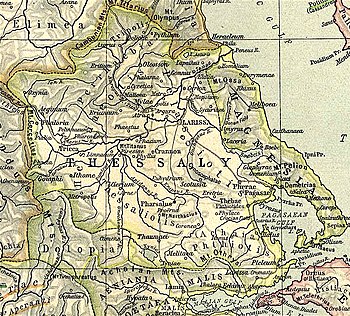Phylace (Thessaly)
39°14′28″N 22°36′04″E / 39.241202°N 22.601194°E

Phylace or Phylake (Ancient Greek: Φυλάκη, Phyláke), was a town and polis (city-state) of Phthiotis in ancient Thessaly.[1] According to Greek mythology, this city was founded by Phylacus. In Ancient Greece, Phylace was a kingdom. Homer writes that this was one of the places subject to Protesilaus, who was the first Greek hero killed in the Trojan War, and the place is frequently mentioned in the Homeric poems.[2][3][4][5] It contained a temple of Protesilaus.[6] Pliny erroneously calls it a town of Magnesia.[7] Strabo describes it as standing between Pharsalus and Phthiotic Thebes, at the distance of about 100 stadia from the latter.[8]
The site of ancient Phylace is at a site called Persouphli or Dervesi, in the municipal unit of Filaki.[9][10]
References
- ^ Mogens Herman Hansen & Thomas Heine Nielsen (2004). "Thessaly and Adjacent Regions". An inventory of archaic and classical poleis. New York: Oxford University Press. p. 716. ISBN 0-19-814099-1.
- ^ Homer. Iliad. Vol. 2.695, 13.696, 15.335.
- ^ Homer. Odyssey. Vol. 11.290.
- ^ Apollonius of Rhodes. Argonautica. Vol. 1.45.
- ^ Stephanus of Byzantium. Ethnica. Vol. s.v.
- ^ Pind. Isthm. 1.84.
- ^ Pliny. Naturalis Historia. Vol. 4.9.16.
- ^ Strabo. Geographica. Vol. ix. pp. 433, 435. Page numbers refer to those of Isaac Casaubon's edition.
- ^ Richard Talbert, ed. (2000). Barrington Atlas of the Greek and Roman World. Princeton University Press. p. 55, and directory notes accompanying. ISBN 978-0-691-03169-9.
- ^ Lund University. Digital Atlas of the Roman Empire.
![]() This article incorporates text from a publication now in the public domain: Smith, William, ed. (1854–1857). "Phylace". Dictionary of Greek and Roman Geography. London: John Murray.
This article incorporates text from a publication now in the public domain: Smith, William, ed. (1854–1857). "Phylace". Dictionary of Greek and Roman Geography. London: John Murray.
- Geographical Dictionary of Greek Mythology - Apd.1.9.12; Apd.Ep.3.14; Arg.1.45; Hom.Il.2.695, 2.700, 13.696, 15.335; Hom.Od.11.290, 15.236.
